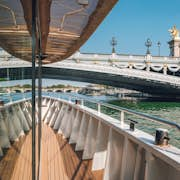

 }})

Exhibition
2 Oct 2024 — 27 Jan 2025
Heinz Berggruen built a notable collection of 20th-century artwork. This exhibition shows his connections with artists and the post-war art market in Paris.
1 option


Combine Musée de l'Orangerie with other Paris favorites. Some things are better together.
In 1922 Claude Monet offered eight of his giant Water Lilies panels to the French state, as a way of commemorating the end of WWI. His only condition was that they be displayed in a suitable venue. The French government found the perfect spot: the Orangerie in the Tuileries Garden.
The Orangerie was built in 1852 as a winter shelter for the orange trees that lined the garden of the Tuileries Palace. For a period of time it was also used as a storehouse for goods, a bunk for soldiers, and as a flexible exhibition space. Monet's generous gift transformed it into the Musée de l'Orangerie, a pre-eminent gallery of Impressionist and post-Impressionist paintings.
The huge (and hugely impressive) Monet paintings are definitely the main event, but they are far from the only reason to visit. The museum also contains works by Cézanne, Matisse, Modigliani, Picasso, Renoir, and Rousseau, among others.







